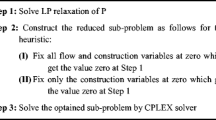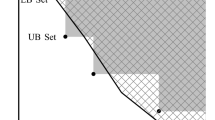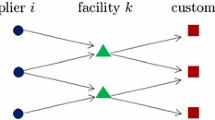Abstract
This paper studies a two-stage stochastic facility location and network flow problem with uncertainty in demand, supply, network availability, transportation costs, and cost of facility activation. The goal is to design a minimum cost long-term network of facilities, in anticipation of uncertain supply, demand, and network structure. Facility location decisions are made in the first stage and facility activation and network flow decisions are made in the second stage. We develop a branch and price algorithm built on a Lagrangian relaxation with two subproblems, one per stage of decision making. To improve convergence, we show that the Lagrangian subproblems could be strengthened by using Benders decomposition. Namely, we add to the first stage Lagrangian subproblem, Benders feasibility cuts generated from the second stage Lagrangian subproblem, and guarantee that the former only generates optimality cuts. Numerical results show that feasibility cuts tighten the Lagrangian duality gap in the root node of the branch and price tree, and solutions generated by our algorithm improve over the literature in terms of computational time and number of solved instances.



Similar content being viewed by others
References
Al-Dhaheri, N., Diabat, A.: A lagrangian relaxation-based heuristic for the multi-ship quay crane scheduling problem with ship stability constraints. Ann. Oper. Res. 248(1–2), 1–24 (2017)
Balcik, B., Beamon, B.M.: Facility location in humanitarian relief. Int. J. Logist. 11(2), 101–121 (2008)
Barbarosoglu, G., Arda, Y.: A two-stage stochastic programming framework for transportation planning in disaster response. J. Oper. Res. Soc. 55(1), 43–53 (2004)
Birge, J.R., Louveaux, F.: Introduction to Stochastic Programming. Springer, Berlin (2011)
Chang, M.-S., Tseng, Y.-L., Chen, J.-W.: A scenario planning approach for the flood emergency logistics preparation problem under uncertainty. Transp. Res. Part E Logist. Transp. Rev. 43(6), 737–754 (2007)
Clark, S., Watling, D.: Modelling network travel time reliability under stochastic demand. Transp. Res. Part B Methodol. 39(2), 119–140 (2005)
Crainic, T.G.: Service network design in freight transportation. Eur. J. Oper. Res. 122(2), 272–288 (2000)
Dell’Amico, M., Novellani, S.: A two-echelon facility location problem with stochastic demands for urban construction logistics: an application within the success project. In: 2017 IEEE International Conference on Service Operations and Logistics, and Informatics (SOLI), pp. 90–95. IEEE (2017)
El-Sayed, M., Afia, N., El-Kharbotly, A.: A stochastic model for forward-reverse logistics network design under risk. Comput. Ind. Eng. 58(3), 423–431 (2010)
Elçi, Ö., Noyan, N.: A chance-constrained two-stage stochastic programming model for humanitarian relief network design. Transp. Res. Part B Methodol. 108, 55–83 (2018)
Fréville, A.: The multidimensional 0–1 knapsack problem: an overview. Eur. J. Oper. Res. 155(1), 1–21 (2004)
Klose, A.: A lagrangean relax-and-cut approach for the two-stage capacitated facility location problem. Eur. J. Oper. Res. 126(2), 408–421 (2000)
Laporte, G., Louveaux, F.V.: The integer l-shaped method for stochastic integer programs with complete recourse. Oper. Res. Lett. 13(3), 133–142 (1993)
Listeş, O.: A generic stochastic model for supply-and-return network design. Comput. Oper. Res. 34(2), 417–442 (2007)
Liu, X., Küçükyavuz, S., Luedtke, J.: Decomposition algorithms for two-stage chance-constrained programs. Math. Program. 157(1), 219–243 (2016)
Lium, A.-G., Crainic, T.G., Wallace, S.W.: A study of demand stochasticity in service network design. Transp. Sci. 43(2), 144–157 (2009)
Manopiniwes, W., Irohara, T.: Stochastic optimisation model for integrated decisions on relief supply chains: preparedness for disaster response. Int. J. Prod. Res. 55(4), 979–996 (2017)
Mete, H.O., Zabinsky, Z.B.: Stochastic optimization of medical supply location and distribution in disaster management. Int. J. Prod. Econ. 126(1), 76–84 (2010)
Mitra, S., Garcia-Herreros, P., Grossmann, I.E.: A cross-decomposition scheme with integrated primal-dual multi-cuts for two-stage stochastic programming investment planning problems. Math. Program. 157(1), 95–119 (2016)
Moreno, A., Alem, D., Ferreira, D., Clark, A.: An effective two-stage stochastic multi-trip location-transportation model with social concerns in relief supply chains. Eur. J. Oper. Res. 269(3), 1050–1071 (2018)
Noyan, N.: Risk-averse two-stage stochastic programming with an application to disaster management. Comput. Oper. Res. 39(3), 541–559 (2012)
Noyan, N., Merakli, M., Kucukyavuz, S.: Two-stage stochastic programming under multivariate risk constraints with an application to humanitarian relief network design (2017). arXiv preprint arXiv:1701.06096
Ogbe, E., Li, X.: A new cross decomposition method for stochastic mixed-integer linear programming. Eur. J. Oper. Res. 256(2), 487–499 (2017)
Pacheco, M., Sharif Azadeh, S., Bierlaire, M., Gendron, B.: Integrating advanced demand models within the framework of mixed integer linear problems: a lagrangian relaxation method for the uncapacitated case. In: 17th Swiss Transport Research Conference (STRC), Number EPFL-TALK-229185 (2017)
Paneque, M.P., Azadeh, S.S., Bierlaire, M., Gendron, B.: Integrating advanced demand models within the framework of mixed integer linear problems: a lagrangian relaxation method for the uncapac-itated case. In: 17th Swiss transport research conference. Transport and Mobility Laboratory (EPFL), Ascona, Switzerland (2017)
Penuel, J., Smith, J.C., Yuan, Y.: An integer decomposition algorithm for solving a two-stage facility location problem with second-stage activation costs. Nav. Res. Logist. (NRL) 57(5), 391–402 (2010)
Pishvaee, M.S., Jolai, F., Razmi, J.: A stochastic optimization model for integrated forward/reverse logistics network design. J. Manuf. Syst. 28(4), 107–114 (2009)
Sen, S., Higle, J.L.: The c 3 theorem and a d 2 algorithm for large scale stochastic mixed-integer programming: set convexification. Math. Program. 104(1), 1–20 (2005)
Sen, S., Sherali, H.D.: Decomposition with branch-and-cut approaches for two-stage stochastic mixed-integer programming. Math. Program. 106(2), 203–223 (2006)
Van Roy, T.J.: Cross decomposition for mixed integer programming. Math. Program. 25(1), 46–63 (1983)
Van Roy, T.J.: A cross decomposition algorithm for capacitated facility location. Oper. Res. 34(1), 145–163 (1986)
Van Slyke, R.M., Wets, R.: L-shaped linear programs with applications to optimal control and stochastic programming. SIAM J. Appl. Math. 17(4), 638–663 (1969)
Vanderbeck, F.: Implementing mixed integer column generation. In: Desaulniers, G., Desrosiers, J., Solomon, M.M. (eds.) Column Generation, pp. 331–358. Springer, Berlin (2005)
Weaver, J.R., Church, R.L.: Computational procedures for location problems on stochastic networks. Transp. Sci. 17(2), 168–180 (1983)
Zeng, B., An, Y., Kuznia, L.: Chance constrained mixed integer program: bilinear and linear formulations, and benders decomposition (2014). arXiv preprint arXiv:1403.7875
Author information
Authors and Affiliations
Corresponding author
Additional information
Publisher's Note
Springer Nature remains neutral with regard to jurisdictional claims in published maps and institutional affiliations.
Rights and permissions
About this article
Cite this article
Hosseininasab, A., Gzara, F. Effects of feasibility cuts in Lagrangian relaxation for a two-stage stochastic facility location and network flow problem. Optim Lett 14, 171–193 (2020). https://doi.org/10.1007/s11590-019-01401-4
Received:
Accepted:
Published:
Issue Date:
DOI: https://doi.org/10.1007/s11590-019-01401-4




